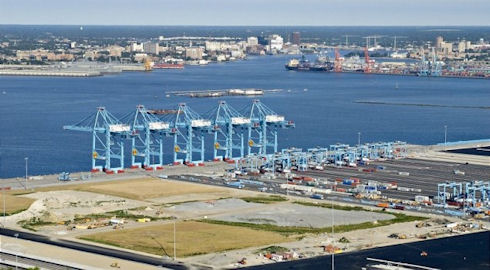Privately owned APM Terminals provides Virginia’s ports something that the state cannot: super-efficient container yards and the ability to expand capacity without incurring $2 billion in debt.
by James A. Bacon
It’s easy to get crane envy when you’re in the port business. The bigger and more modern the crane, the faster it can unload cargo containers from ships at dock. The hoists are huge, they’re painted bright colors and they are highly visible. But there’s more to creating a quick turn-around time in a port than installing the latest, greatest cranes. It is just as critical to sort the containers inside the terminal in order to load them expeditiously, whether onto trucks, trains or ships.
That’s a task at which APM Terminals excels. The patented processes that make APM’s Portsmouth facility hyper-efficient are invisible to the untrained eye — the container yard, where containers are stacked four and five high, looks much like that of any other port. What sets the yard apart is the way in which the computer-guided gantries re-stack the RFID-tagged containers so that the first to be loaded is the first to be accessed.
The company’s Portsmouth complex is a “one-of-a-kind operation in the Western Hemisphere,” says John Crowley, senior vice president for law and regulatory affairs for APM Terminal’s America Region. “It’s so much more than the cranes. It’s the ability to handle a densified container yard.”
It is difficult to fully understand the controversy swirling around APM Terminals’ proposal to consolidate and lease Virginia’s public and private ports without grasping the key role of that unsung workhorse of modern-day ports, the container yard.
In 2010 APM Terminals entered into a deal to lease its Portsmouth operation, completed three years before at a cost of $540 million, to the state. The VPA had long-term contracts that guaranteed a strong flow of business through its Portsmouth terminal but APM, slammed by the recession, was operating at 40% capacity. By absorbing APM into its system, Crowley explains, the port authority was able to shift much of its container traffic to the more efficient terminal — a win-win arrangement.
That lease lasts until 2030. Now, with the economy recovering and the prospect for a surge in container traffic from a Panama Canal expansion scheduled for 2015, the Netherlands-based APM Terminals proposes a different arrangement: It wants to give its state-of-the-art terminal to the state, and then lease back the whole kit and kaboodle for 48 years.
Under that proposal, APM Terminals would pay fixed concession payments totaling between $1.1 billion and $1.3 billion (adjusted for net present value). The company would pay the state an additional $380-$600 million in revenue sharing contingent upon cargo growth, commit to making $650-$830 million in capital investments, and pay $300-$450 million in state and local taxes. All told, the company contends, the package has a net present value to Virginia and Hampton Roads localities of between $3.1 billion and $3.9 billion.
Upon receiving APM’s unsolicited proposal in April, the McDonnell administration sought alternatives. It received three: from Deutsche Bank/RREEF Intrastructure, Virginia International Terminals (the operating arm of the Virginia Port Authority) and the Carlyle Group, which has since withdrawn its offer. The Office of Public Private Partnerships, under the Secretary of Transportation, will evaluate the three remaining proposals.
Many members of the Hampton Roads maritime community are skeptical of the APM deal. What could a private owner do, they wonder, to stimulate growth and investment in the port that the state-owned Virginia Port Authority couldn’t? What efficiencies could APM Terminals bring to bear that would offset the private-sector need to generate a profit? And what assurances do Virginians have the APM Terminals, an affiliate of the Maersk shipping line and operator of 63 ports around the world, won’t shift cargo to other ports, if it proves advantageous to do so?
In an extended interview with Bacon’s Rebellion, John Crowley and Adam Beauchamp, the executive in charge of strategy and corporate development for APM’s America operations, laid out their vision for the future of Virginia’s maritime ports and why they think their proposal is the best one. Read more.



